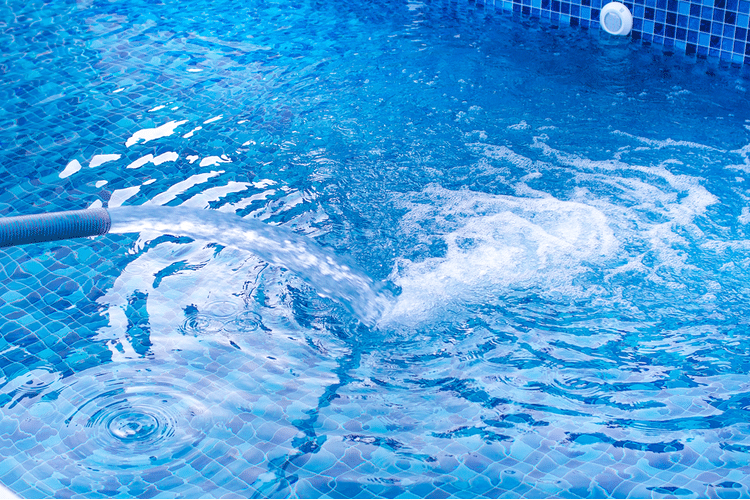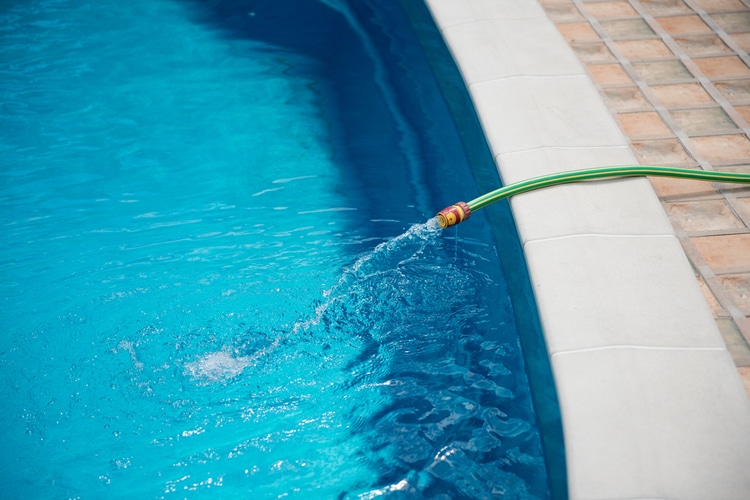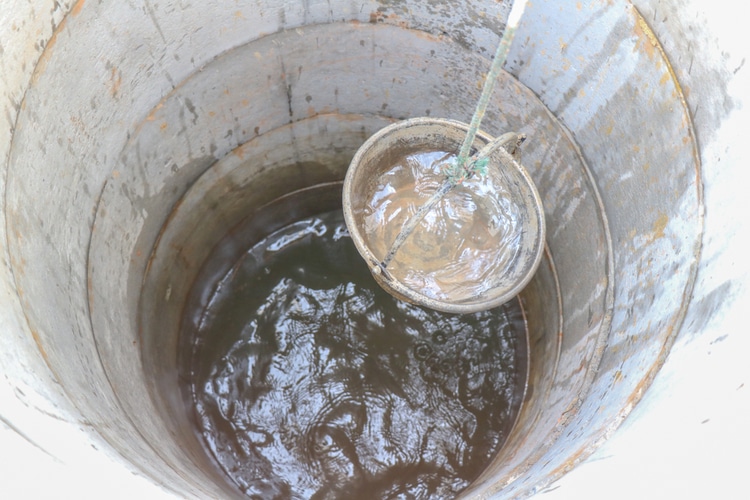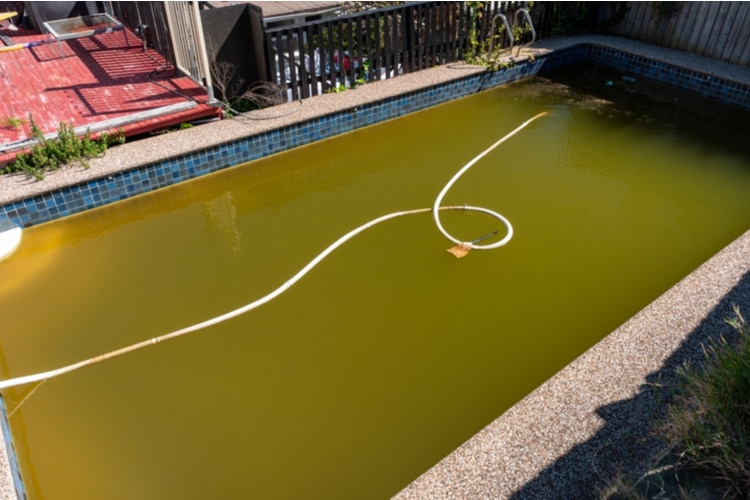If you have a well on your property and would like to use well water to fill your pool, it’s essential to know how to do it. First, you have to test the water to ensure that it’ll be safe to swim in and understand the pros and cons of going with well water instead of city water.
Keep reading to learn about filling a pool with well water, with step-by-step instructions.

How to Fill Pool with Well Water
Below are instructions on the easiest way to fill up your pool with well water:
Materials:
- Garden hose
- Biocide
- Five-gallon bucket
Before filling your swimming pool, you’ll need to run some testing first to see if your filter can adequately clean the water. For starters, well water is much rawer than water from a local municipality center. Moreover, more metals and ions are in well water, making it more difficult for filters and pumps to clean the water.
After you’ve done the basic water test and all is well, you can begin filling your pool up with the well water. If the water is not suitable, you will have no choice but to contact a water company to have them deliver water that is much cleaner than your well water.
Follow these steps:
How to Fill a Pool with Well Water
- Quickly Test Well Water With Biocide
Take your bucket, fill it with water from your well, and add biocide. You can find biocide from your local store and just follow the directions on the packaging.
Afterwards, wait between five and ten minutes. If the water turns green or brown, it contains many ions. You’ll need a sand filter because a cartridge filter will be unable to remove the metal. - Connect Hose to Well Water Pump
Take the hose and connect to the tap closest to the well pump. Alternatively, you can connect to a faucet inside your home as well.
- Place Hose inside the Pool
Take the open end of the hose and place it inside your pool. Next, turn on the water and ensure that the hose remains in the pool.
- Wait for the Pool to Fill Up
Depending on the water pressure, smaller pools will take approximately 6 – 24 hours to fill, while larger pools will take 48 hours.
Now that you have your pool filled with well water, take a sample to your local pool supply center to get appropriately tested (if possible). That will remove all doubt about whether or not your pool’s water is sufficient.
Filling a Pool With Well Water vs City Water – Which is Better?
There are a few ways that you can go about filling your swimming pool.
City Water

Of course, you can use a hose and fill your pool from your own water supply. On that note, if you do have city water, you’ll usually be charged for the water going into the pool, and the city will produce a discharge fee.
There’s a chance that if you consult with the company of your municipal water supply that they may forgive the cost. It’s definitely worth the shot.
If you happen to fill your pool from a municipal source or the city, be sure to test this water to know what it contains. For example, some areas will treat water to give it a high pH, and water added to a swimming pool with a high pH will create a scale in the pool and cause it to change color. Knowing what your water is made of allows you to adjust your water chemistry appropriately.
Consult your local utility office to see how much money you can expect to pay per gallon so that you’re not caught off guard when the bill arrives. You may be surprised to see how much money you’ll be spending on a complete fill or refill; however, this price will still pale compared to having your water delivered from a water company.
Well Water

You can also opt to use well water to fill your swimming pool. However, many areas in Michigan will contain many minerals and lots of iron which will cause discoloration and staining of the pool surfaces and the pool water.
If you happen to live in an area with high iron content, put your water through a pre-filter before putting it into your swimming pool. You can use a product designed to remove iron from pool water, such as Ferri-Iron Tablets.
Frequently, well water will have a distinct and apparent taste due to hydrogen sulfide and other minerals. The city water plants typically filter out elements capable of permeating the water table. However, when you get your water directly from the well, you are also everything the water has touched and dissolved on the way to your well.
All of the excess minerals can present a problem when balancing and sanitizing your water. While iron and copper, and other metals can stain and damage your liner, sulfur compounds keep your shock from working correctly. The irony is that free pool water can actually cost you more if you have to blow you on trying to maintain healthy pool chemistry.
Exercise caution and test for chemicals in your well water and other irritants such as copper, hydrogen, iron, and sulfide in excessive amounts.
Though the cost per gallon may not be problematic, the capacity will be a consideration. You must ensure that the well can accommodate the necessary volume to fill the pool. You don’t want to run your well until it goes dry, as you’ll have to pay thousands of dollars to drill another one. That’s weeks of wasted time and lost effort.
If you consider these factors, you may be able to save quite a bit of money by filling your pool with well water instead of city water.
Note: If the only water supply you have to your home is the well, you probably have a water softener system with the attached pump. That will create fewer concerns about whether your water quality is compromised. If this is the case, you can fill your pool with a hose as you would if you were using the city water supply.
However, this will require you to transfer thousands of gallons through the softener system, so don’t forget to calculate costs for electricity and salt needed to pump the water into the pool.
If You’re Filling a Pool With Well Water, How Long Should You Let it Run at a Time?
Start water running at half the potential speed for close to an hour. Next, stop it and wait for an hour so that it can refill. Continue this method of one hour on, one hour off, until you have filled the pool.
How to Filter Well Water for a Pool?
To filter well water, you have to first understand what substances you want to get rid of. This factor is the primary reason you get a well water test kit before doing anything. It’s unsafe to presuppose that all well water will have the same chemical composition.
It’s easy to buy test strips for well water at a local store or online.
Follow the instruction manual on installing the water filter system, and make sure you place it between the swimming pool and the well. It’s simpler if you have pre-existing plumbing that runs from the house to your well. If that’s the case, you don’t have to cut an area in the supply line to fit onto the water filter.
Get the compression fitting and connect them to the cut pipe ends, and secure each one to the filtration systems outlet and inlet ports. You have to join the pipe from the well to the inlet port of the water filter and let the tube that comes from the swimming pool connect with the outlet section of the filter.
What is the Best Well Water Filter for a Pool?
Going back to the test kit helps you know which substances in the well water are harmful. If you don’t want those kinds of compounds floating around in your pool, you have to make certain investments. For example, you’ll see that minerals from the well water make the water hard, requiring a water softener for pool or a more sophisticated whole house well water softener system.
Other wells have sediments, small stones, and dirt transferred into the water. A sediment filter is a fantastic choice for situations such as these. The maintenance is low, and it’s inexpensive. Consider the iSpring WSP-50 Sediment Water Filter for a reliable system to keep your water safe.
For something more powerful, a whole house well water filter system is the best choice. It’ll come with a sediment filter, a carbon block filter, a CTO membrane, and other special features.
Why is My Pool Water Brown?

If you notice that your pool is brown after filling it with well water, the culprit is a metal such as iron oxidizing in the pool water. Oxidized metals can turn a rusty brown color in the water and discolor the entire pool.
How to Fix Brown Pool Water
Here’s how to get your water back clear if it turns brown:
Step 1: Ascorbic Acid
Using ascorbic acid is the first step to cleaning your pool because it dissolves the iron and metals in your water. Get one pound of the ascorbic acid, apply it to the pool water, and wait one hour for it to circulate throughout. You’ll see an immediate result.
Step 2: Shut Down the Pools Pump
After around an hour (wait an extra hour if the stains are stubborn), you’ll notice the color lifting. Turn the pool off at this point.
Step 3: Use Revive (16 oz)
The iron will be sitting on top of the water, and this is when you use a bottle of Revive (16 oz). This substance pulls the iron to the bottom as it transforms it into sediments. Wait one day and don’t use the pool during this time.
Step 4: Clean the Debris
Get a quality vacuum cleaner to clean the debris from the pool bottom. Turn in the waste setting, or you risk damaging the system.